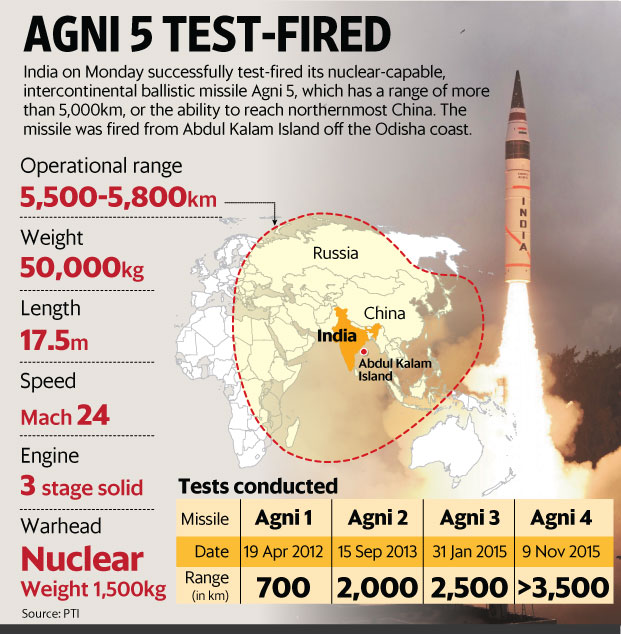
India Test-Fires Agni-V
Agni-5, the Long Range Surface-to-Surface Ballistic Missile was successfully flight tested by DRDO on 26 December from Dr. Abdul Kalam Island, Odisha.
Key Features
- It is under the Integrated Guided Missile Development Programme(IGMDP) and is a part of the Agni series of missiles.
- Agni-5 has a range of more than 5,000km (3,100 miles).
- It has the capacity to carry Multiple Independently Targetable Re-entry Vehicles (MIRV) payloads, which can handle multiple warheads at different targets.
- The missile is driven by solid propellants, and has all-weather, any-terrain launch capability.
- Agni-5 is a surface-to-surface missile with a fire-and-forget system to follow ballistic trajectory, and hence, is not easy to detect for others.
- The Agni-5 takes India into a highly exclusive club of nations that include the USA, Russia, China, France and the United Kingdom in possession of such long range weapons.
Significance for India
- This will be the first intercontinental missile that will allow India to strike neighbouring countries across Asia and into Europe.
- The missile once officially launched will give our country the ability to attack or threaten neighbouring countries like China with nuclear weapons. This is something which the country presently lacks.
- Agni-5 will give the armed forces the much-need operational adjustability to quickly transport and fire the missile from anywhere they want.
- This is also a road-and-rail-mobile canister that can be fired from stop-to-launch within a short time, along with the added benefits of longer shelf-life, higher reliability, and reduced maintenance.
Background
- This was the 4th test of Agni-5 missile and the second one from a Canister on a Road Mobile Launcher. All the four missions have been successful.
- The nuclear missile climbed to a height of more than 600 km and hit the designated target point perfectly in the Indian Ocean after 20 minutes.
- India’s ICBM arsenal includes the Agni-1, 2, 3 & 4, along with Brahmos cruise missiles.
- Of this series, the very first Agni-1 was developed and inducted back in 1989. It had a range of 700 km back then. Following upgrades to the range of the missiles includes 2,000 kms for the Agni-2, while the Agni-3 has 2,500 km range and Agni-4 has 3,500km range.
- India conducted the first test launch of the Agni-5 in 2012, the second in 2013 and the third one in 2015.
What is ICBM?
- Intercontinental Ballistic Missiles (ICBMs) have ranges of greater than 5,500 km.
- Once launched, the missile passes through three phases of flight: boost, ballistic, and reentry.
- The missile can only be guided during boost phase with inertial or stellar or both.
- Inertial guidance uses onboard computer driven gyroscopes to determine the missile's position and compares this to the targeting information fed into the computer before launch.
- Stellar guidance uses an optical tracking system to triangulate star positions and update targeting information when it is out of the earth's atmosphere.
- Targeting cannot be changed after launch, nor can strategic missiles be recalled or destroyed in flight.
- These guidance systems produce accuracies measured in hundreds of feet at ranges of 7,000 miles.
- Payloads of strategic missiles consist of nuclear warheads which cannot arm themselves until the onboard computer confirms that all three phases of flight have been completed.
Other ICBM Countries
Russia: Russia's R-36M (SS-18 Satan) missile is the world's longest range Intercontinental Ballistic Missile. It has a strike range of 16,000 kilometers. With a weight of 8.8 tonnes the R-36M is also the heaviest ICBM in the world.
USA: The LGM-30 Minuteman ICBM was first deployed in 1970. It has an estimated operational range of between 12,000 km to 15,000 kilometers.
China: China admitted that India's Agni-V is comparable to its DF-26 ICBM which is also nicknamed Guam Killer. The IRBM, with reported range of 3,500 km, has the ability to reach a major US base in Guam in the western Pacific.
DF-26, a two-stage solid fuel rocket IRBM, measures 14 meters long with a diameter of 1.4 metre and a launch weight of 20 tonnes. It can carry a nuclear or conventional warhead that weighs 1,200-1,800 kilograms and has an estimated maximum range of more than 5,000 km.
China believes Agni-5, with reported range of 5,000 kilometers, is the only other missile in the world which can hit targets over 8000 kilometers with a lighter payload, making it much better missile system than DF-26.
Dong Feng 5A is China's longest range ICBM and is capable of striking targets within the range of 13,000 kilometers.
France: The M51, which was inducted into service aboard the French Navy's Triomphant class submarines in 2010, has an operational range between 8,000 kilometers to 10,000 kilometers. An improved version with new nuclear warheads was commissioned in 2015. The three-stage missile weighs 50 tonnes and can carry six independently targetable re-entry vehicles with a yield of 100kt-150 kilo tonnes each.
Israel: Produced by Israel Aerospace Industries, Jericho-III is believed to be a three-stage solid propellant rocket with a payload capacity upto 1,300 kgs. The missile can hit targets within a range of 4,800 to 6,500 kilometers. The missile can be equipped with a single 750 kg nuclear warhead or two or three low yield MIRV warheads.
Pakistan: Though, Pakistan claims that India won't be able to defend itself from its lethal missile attack, the country doesn't have a missile in its arsenal that matches Agni-5.
|
country |
Ballistic Missile |
|
Russia |
R-36M (SS-18 Satan) missile |
|
USA |
LGM-30 Minuteman |
|
China |
Dong Feng 5A |
|
France |
M51 |
|
Israel |
Jericho-III |
|
Pakistan |
Baseless arguments |